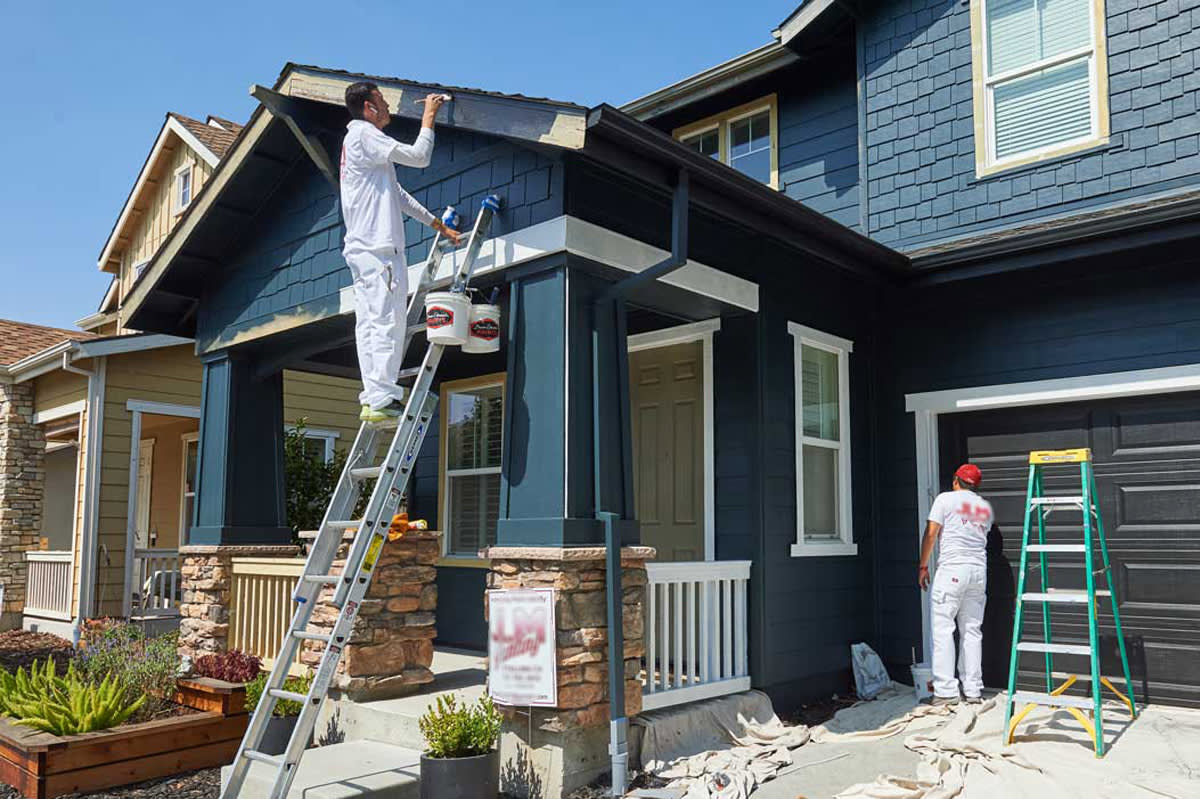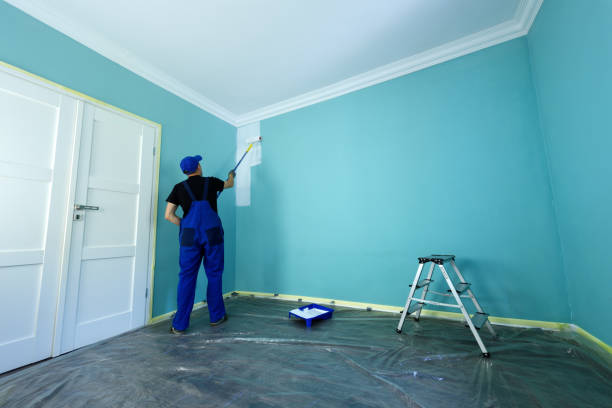Remain Ahead With New Paint Trends: Blending Techniques for Modern Interiors

The Surge of Shade Gradients in Interior Decoration
As designers significantly look for ingenious ways to boost areas, the increase of color gradients in interior layout has gathered considerable focus. This method, identified by the smooth shift between two or even more colors, enables a dynamic visual result that can transform a common area right into a vibrant environment. Shade slopes can stimulate emotions, affect assumptions of room, and create centerpieces, making them a versatile selection for various layout styles.
The application of gradients extends beyond walls; they can be effectively used in furnishings, fabrics, and accessories. Developers frequently try out varying tones to attain deepness and intrigue, attracting a variety of appearances from minimal to eclectic. Additionally, the flexibility of slopes enables their usage in both commercial and household setups, accommodating varied clients. As patterns advance, using shade slopes indicates a change in the direction of more tailored and expressive indoor rooms, showing individual tastes and way of lives.
Welcoming Ombre Strategies for a Dynamic Look
Ombre strategies have actually emerged as a captivating choice for those aiming to include depth and motion to modern interiors. This gradient result shifts smoothly from one shade to an additional, creating an aesthetically striking focal point in any type of space. Designers appreciate ombre for its flexibility; it can be used to wall surfaces, furnishings, or even ornamental accents, permitting unique expressions of style.
The method functions specifically well with soft shades, supplying a peaceful atmosphere, while strong shades can invigorate a room. House owners can explore numerous shade palettes, selecting different tones for a significant effect or harmonious tones for a refined impact. The application of ombre is not limited to a single wall; it can prolong across a room, boosting the perception of room and light.
As a contemporary fad, ombre techniques accommodate varied preferences, permitting people to personalize their interiors and embrace creativity in their design method. corpus christi paint store.
Distinctive Walls: Layering Paint for Depth and Interest
Distinctive walls can greatly boost the visual appeal of modern insides by adding deepness and passion. Methods for producing structure, thoughtful color combinations, and the right devices for layering are necessary components in accomplishing this effect. Discovering these aspects enables a dynamic and individualized method to interior layout.
Techniques for Structure Development
Developing visual passion in interior rooms commonly hinges on the artful application of structure. Different techniques can be employed to achieve this, such as sponging, dustcloth rolling, and stippling. Sponging entails utilizing a moist sponge to use a 2nd color over a base layer, creating a soft, varicolored impact. Rag rolling, on the other hand, makes use of a rolled dustcloth to apply paint, leading to a more vibrant texture. Stippling uses a tight brush or device to dab paint onto the surface, creating an one-of-a-kind pattern. Additionally, layering various surfaces, such as matte and glossy, can improve deepness. These strategies not only offer aesthetic allure but also add to the overall atmosphere of modern interiors, encouraging a tactile experience.
Color Combinations for Effect
Layering paint not just boosts texture however likewise opens up a globe of color combinations that can substantially affect the state of mind of an area. By blending complementary tones, developers can create a harmonious effect that welcomes heat or coolness, depending on the preferred atmosphere. Abundant earth tones coupled with soft pastels can evoke a calm atmosphere, while vibrant, contrasting colors can include vibrancy and energy. Furthermore, integrating metallic or shiny surfaces within the layers can introduce a vibrant aesthetic component, catching light and enhancing the deepness of the color system. Ultimately, thoughtful color combinations via layering paint offer a chance to express individual style while changing average walls into charming focal factors.
Tools for Layering Impact
Numerous tools are crucial for achieving a successful layering effect in paint applications, which can change wall surfaces right into charming visual experiences. Rollers and brushes are basic, with varied sizes enabling for various structures and surfaces. Specialty devices like sponges and rags can develop special patterns and depth, while palette blades offer precision for even more specified lines. For bigger areas, utilizing a stippling brush can add an intricate surface. In addition, spray weapons can effectively use multiple layers for a smooth, also layer. Painters should additionally consider painter's tape to create tidy sides between layers. By using the right tools, one can properly improve the visual allure of insides, making each wall surface an interesting prime focus.

The Power of Shade Blocking in Modern Spaces
As contemporary interior decoration remains to develop, color obstructing becomes an effective strategy that can transform areas with strong visual effect. This method entails the critical placement of contrasting shades to develop defined areas within a space, enhancing both the visual allure and performance of the area. corpus christi paint store. By using large swathes of shade, developers can guide the eye and stress building components, causing a vibrant environment
Shade blocking is not limited to walls; it can also be used to furniture and decor, permitting for unlimited customization. Combining a dynamic tone with a neutral tone can develop a striking focal point while maintaining equilibrium. This method motivates creative thinking, enabling property owners to share their characters via unique shade combinations. Ultimately, shade obstructing works as an effective way to breathe new life into contemporary interiors, making spaces really feel fresh, energised, and visually appealing.
Including Metallics for an Attractive End up
How can metallics raise the refinement of modern-day interiors? Metallic finishes serve as a striking focal factor, including deepness and visual passion to rooms. They can change a standard space right into an elegant resort through the subtle interaction of light and representation. Developers commonly suggest incorporating metallics in accent wall surfaces, ceilings, or furniture to develop a lavish atmosphere without frustrating the space.
Different metallic tones-- such as silver, bronze, and gold-- offer flexibility, allowing homeowners to tailor their visual. For circumstances, a soft gold can pass on warmth, while a sleek silver can provide a modern touch. When matched with neutral tones, metallics boost the total style, supplying an innovative comparison that attracts the eye.
Integrating metallic paint into trim or moldings can also elevate architectural information, developing a polished surface. Ultimately, the critical use metallics can instill modern-day interiors with beauty and improvement, making them absolutely bewitching.
Imaginative Use Stencils for Special Patterns
Changing wall surfaces with patterns can infuse modern insides with unique character and design. This artistic technique enables home owners and designers to develop customized patterns that reflect personal appearances. Patterns can vary from elaborate geometric styles to wayward concepts, allowing a vast array of expressions. By picking contrasting colors, stencils can raise a room's visual allure and work as centerpieces without overwhelming the space.
Additionally, patterns are versatile; they can be related to various surface areas, including wall surfaces, furniture, and also ceilings. This adaptability makes stenciling an ideal choice for do it yourself enthusiasts wanting to enhance their space affordably. In addition, the convenience of application and elimination allows for trial and error, allowing individuals to rejuvenate their decor with very little effort. Inevitably, imaginative usage of patterns not only transforms ordinary surfaces however likewise supplies an opportunity for self-expression, making them a trending selection in modern interior decoration.
Mixing Matte and Glossy Surfaces for Comparison
The interplay of matte and shiny finishes can produce a striking visual dynamic in contemporary insides. Designers often utilize this contrast to enhance building features and specify rooms. Matte surfaces, with their soft, non-reflective top quality, can produce a sense of warmth and intimacy, making them excellent for walls and bigger surface areas. In comparison, glossy finishes reflect light, adding vibrancy and depth, making them appropriate for accents such as trim, moldings, or furniture.
The mix of these appearances can assist the eye and emphasize centerpieces within an area. Coupling a matte-painted wall surface with glossy cabinets can create an innovative balance. Additionally, the cautious application of both finishes can evoke different state of minds while enhancing the overall aesthetic. As house owners get more info progressively look for individualized rooms, blending matte and shiny surfaces uses a functional technique to attaining modern sophistication and visual rate of interest in indoor style.
Often Asked Questions
What Devices Are Best for Blending Paint Techniques?
A selection of devices are excellent for mixing paint techniques, consisting of foam rollers, brushes with soft bristles, sponge applicators, and airbrushes. Each tool offers one-of-a-kind results, enhancing the blending process for different creative applications.
Exactly How Can I Take Care Of Mixing Mistakes?
To take care of mixing mistakes, one ought to lightly sand the afflicted location, use a guide if needed, and afterwards carefully reapply paint making use of a soft brush or sponge to achieve a smooth change and recover the wanted result.
Exist Specific Paint Brands Recommended for Blending?
A number of paint brands are suggested for mixing, including Benjamin Moore, Sherwin-Williams, and Behr. These brands offer premium surfaces and a vast array of colors that assist in smooth shifts and effective mixing methods in numerous indoor tasks.
Can I Mix Paint Without Expert Aid?
Yes, blending paint without professional assistance is feasible. With practice and the right tools, individuals can accomplish desirable results. Numerous online tutorials and guides can assist in mastering blending strategies for personal tasks.

The Length Of Time Does Blended Paint Last on Walls?
Blended paint can last anywhere from 5 to 10 years on wall surfaces, relying on variables such as the high quality of paint utilized, surface preparation, and environmental problems. Routine maintenance generally enhances longevity and look.
As designers progressively look for innovative means to boost areas, the increase of color slopes in interior design has actually gathered considerable interest. The strategy functions particularly well with soft tones, providing a tranquil ambiance, while vibrant shades can invigorate a room. Methods for creating texture, thoughtful color mixes, and the right tools for layering are essential parts in achieving this result. Layering paint not only boosts texture however likewise opens up a globe of shade combinations that can significantly affect the mood of an area. As modern interior layout proceeds to advance, color blocking emerges as an effective strategy that can transform spaces with bold visual influence.